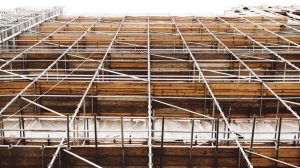It seems that every week there is news of a new application for nanotechnology— the applied science of the very small.
Scientists working with materials at the smallest scale are finding ways to engineer them to produce what has come to be known as nanomaterials— materials that often look like things we’re accustomed to, but which have special characteristics undreamed of even five years ago.
Consider paint. Nanoparticles added to paint can make it resistant to corrosion, or scratch-proof. Nanoparticles can make paint self-cleaning, so grit and grime on the surface is washed away anytime there’s rain.
And now a Scottish scientist is developing a paint that, thanks to nanoparticles added to it, can spot microscopic faults in bridges and other structures.
David McGahon, of the University of Strathclyde, in Glasgow, has hit upon a formulation that includes fly ash and carbon nanotubes to create a paint that can carry an electrical current.
Carbon nanotubes are getting a lot of attention from scientists, partly because they are extremely strong, partly because they are excellent conductors of electricity and when they bend, their conductivity changes.
That, McGahon reasoned, would make them useful as sensors if he could find a way to install them. Painting them on a surface seemed a likely solution.
The idea has been successful so far in laboratory tests. Testing the paint in the field is just beginning now.
Some sophisticated engineering was involved because the carbon nanotubes are microscopically small, yet must be aligned to ensure conductivity. They are suspended in a solution with fly ash, yielding a material that is somewhat like a very thin mixture of cement and water.
Electrodes incorporated into structures will be attached to a small battery and small wireless transmitters spotted through the structure. They will send information to a data logger.
Any significant change detected in the flow of electrical current can be interpreted as a sign of a structural defect, says McGahon, so engineers can be alerted to the possibility of a problem long before there is any visual hint of it.
McGahon notes that most inspections for structural defects are still done visually, which means an engineer has to go to the site, so he foresees his paint being especially useful where visual inspection is difficult— including many parts of bridges, tunnels and the like, or in tall structures like wind turbine masts.
While a battery will be needed, he suggests that other power sources are available thanks to new energy-harvesting methods.
“If you’re in a tunnel, you can use the vibrations of cars or trains going past to harvest power. If you’re on a bridge, you could maybe use a solar panel,” he says.
“The idea is to make it more sustainable so you’re not running out to your bridge . . . to change the battery all the time.”
McGahon is also looking at the possibility of incorporating electrical impedance tomography technology into any structures that are to be monitored.
That technology creates a sort of map of the conductivity of a structural member so if a crack begins to appear it will show up on an electronic model of the member, showing exactly where the problem is developing.
To some, all this might sound like something out of science fiction, but we can expect to see a lot more ideas incorporating nanomaterials.
Governments and public and private research organizations are spending $4.5 billion a year worldwide to tap the promise of nanoscience, and an important part of that is going to research to find uses for nanoparticles, including carbon nanotubes, in construction materials.
It’s a drive that will continue, given the economic and environmental need to develop a greater level of sustainability in the things we build.
Korky Koroluk is an Ottawa-based freelance writer. Send comments to editor@dailycommercialnews.com











Recent Comments
comments for this post are closed